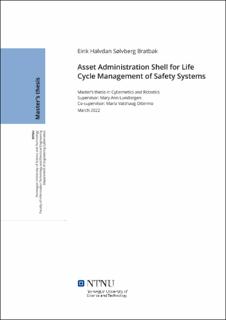| dc.contributor.advisor | Lundteigen, Mary Ann | |
| dc.contributor.advisor | Ottermo, Maria Vatshaug | |
| dc.contributor.author | Bratbak, Eirik Halvdan Sølvberg | |
| dc.date.accessioned | 2022-05-31T17:19:22Z | |
| dc.date.available | 2022-05-31T17:19:22Z | |
| dc.date.issued | 2022 | |
| dc.identifier | no.ntnu:inspera:91918311:45135875 | |
| dc.identifier.uri | https://hdl.handle.net/11250/2997101 | |
| dc.description.abstract | Denne oppgaven utforsker Asset Administration Shell (AAS) og foreslår fem modeller for å representerer informasjon relatert til instrumenterete sikkerhetssystem (SIS) i Asset Administration Shell. Asset Administration Shell er en implementering av den digitale tvillingen for Industrie 4.0 system. AAS representerer og beskriver et asset digitalt. I AAS er forskjellige aspekter av et asset beskrevet i submodeller. En submodell er en samling av properties som hver representerer en verdi som beskriver en karakteristikk av et asset.
Denne masteroppgaven fokuserer på bruk av AAS med utstyr som er en del av instrumenterte sikkerhetssystemer. SIS er industrielle systemer som er designet til å detektere og minske farlige hendelser som kan føre til skade på mennesker, miljø og utstyr. En SIS utfører en eller flere instrumenterte sikkerhetsfunksjoner (SIF). En instrumentert sikkerhetsfunksjon består vanligvis av tre subsystemer: sensorer, logiske enheter og aktuatorer.
Fordi rollen til SIS og SIF er å forhindre farlige hendelser er det viktig å samle og analysere pålitelighetsdata om disse systemene. APOS prosjektet på SINTEF har definert taksonomier brukt til å forenkeligjøre og standarisere oppfølgingsprosedyren av utstyr som er en del av SIS og SIF. Disse taksonomiene dekker klassifikasjon av utstyr og forskjellige aspekter relatert til feil på SIS utstyr.
Denne masteroppgaven er basert på rapporter og taksonomier publisert av APOS og spesifikasjoner som definerer metamodellen til AAS. AAS metamodellen beskriver strukturen til AAS og definerer objekter og attributter brukt til å modellere AAS og submodeller.
Denne masteroppgaven foreslår tre submodeller og to AAS som beskriver SIS relatert informasjon basert på AAS metamodellen og APOS rapportene. The foreslåtte modellene er generiske og kan brukes for forskjellige typer utstyr. Forslagene er:
En submodel for utstyrsklassifisering
En submodel for mulige feilmoder
En submodel for feilklassifikasjon og registrering
Et AAS for en utstyrsgruppe
Et AAS for en SIF
Analyse av forslagene viser at rammeverket for AAS er velegnet til å modellere utstyrsklassifikasjon og utstyrsgrupper. Representasjon av mulige feilmoder viste seg å være vanskelig å modellere siden ingen metode ble funnet for å indikere at en property representerer en mulig feilmode og ikke den nåværende feilmode-tilstanden til et asset. Feilklassifikasjons submodellen sitt omfang ble funnet til å være for stort siden den inneholder property som beskriver både asset spesifikke og utstyrsgruppe spesifikke aspekter. AAS ble funnet til å være egnet for å modellere sammensetningen til en SIF, men å bestemme hvilke submodeller som skal inkluderes i et SIF AAS krever identifikasjon av standarder og spesifikasjoner brukt til å beskrive forskjellige aspekter av SIF. | |
| dc.description.abstract | This master's thesis explores the Asset Administration Shell (AAS) and proposes five models for representing information related to safety instrumented systems (SIS) in the Asset Administration Shell. The AAS is the implementation of the digital twin for Industrie 4.0 systems. The AAS digitally represents and describes an asset. In the AAS, different aspects of an asset are described in submodels. A submodel is a collection of properties that each represent one value describing a characteristic of an asset.
This master's thesis focuses on using the AAS with equipment that is part of safety instrumented systems. SISs are industrial systems designed to detect and mitigate dangerous events that can cause harm to humans, the environment, and equipment. An SIS performs one or more safety instrumented functions (SIF). A safety instrumented function typically consists of three subsystems: sensors, logical units, and actuators.
Because the role of SISs and SIFs are to prevent dangerous events, it is vital to collect and analyze reliability data on these systems. The APOS project at SINTEF has defined taxonomies used to simplify and standardize the follow-up procedure of equipment that is a part of SISs and SIFs. The taxonomies cover the classification of equipment and different aspects related to failures of SIS equipment.
This master's project is based on reports and taxonomies published by APOS and specifications defining the metamodel of the AAS. The AAS metamodel describes the structure of the AAS and defines the objects and attributes used to model AAS and submodels.
This master's thesis suggests three submodels and two AAS that describe SIS-related information based on the AAS metamodel and the APOS reports. The suggested models are generic and apply to different types of equipment. The suggestions are:
A submodel of equipment classification
A submodel for possible failure modes
A submodel for failure classification and registration
An AAS for an equipment group
An AAS for a SIF
Analysis of the suggestions shows that the framework of the AAS is well suited to model equipment classification and equipment groups. Representing a possible failure mode proved difficult as no method was found to indicate that a property represents a possible failure mode, not the current failure mode state of the asset. The failure classification submodel's initial scope was found to be too large since it contains properties describing both asset-specific and equipment group-specific aspects. The AAS was found to be suited for modeling the composition of a SIF, but deciding which submodels to include in the SIF AAS requires identifying standards and specifications used to describe different aspects of SIFs. | |
| dc.language | eng | |
| dc.publisher | NTNU | |
| dc.title | Asset Administration Shell for Life Cycle Management of Safety Systems | |
| dc.type | Master thesis | |
